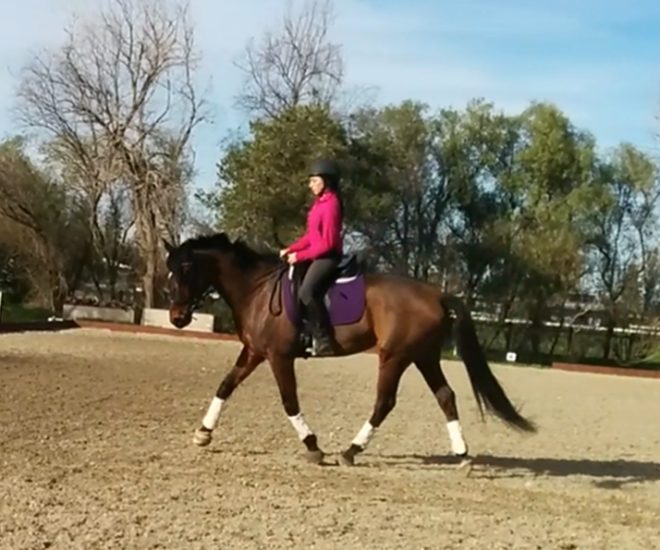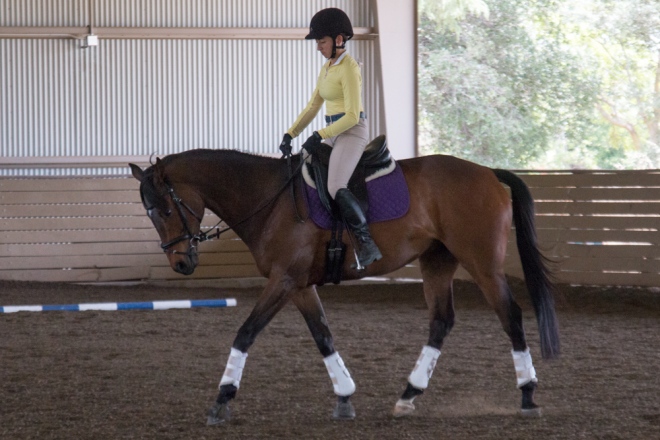When we started Murray’s dressage training there was plenty of good to work with: rhythmic gaits, a good cadence, and the good type of sensitivity. But he was also terribly spooky, suspicious, stiff-backed and –necked, and uncomfortable with the idea of using his body in a different way. And his gaits, while very steady, were short and stiff.
Both my regular trainer and my dressage trainer, Tina Steward, wanted me to get Murray using his whole body to move, instead of just stabbing his legs around, and to unlock his neck, back, and pelvis. Tina’s main method of doing this is by over-flexing a horse to the inside with a strong, steady inside rein. A steady inside rein can act almost like a side rein – when the horse finally gives through the neck the contact immediately softens. My very first lesson with Tina focused on exactly this: encouraging Murray to lower his head and thereby lift the base of his neck, and then later simultaneously do this while changing bend on a serpentine. It was incredibly challenged for my four year old – he was four then!!! – and gave me an effective tool for encouraging Murray to use his neck and come through his back. So for a long time I rode Murray off of pretty much just that inside rein – the outside rein was there and helped with steering, but all of my connection was with the inside rein.
 Just starting to think about the outside rein…
Just starting to think about the outside rein…
I knew, and know, that this wasn’t the “right way”. You don’t ride dressage completely off of the inside rein, and the point beyond which a horse can go around with his head essentially as low as he can get it is around intro level. But it was an incredibly useful tool to get Murray thinking about using his body the right way. It got him there without a fight, when more conventional methods of encouraging a horse to lift through his back and come into the bridle would have (and did, on the few occasions we employed them) resulted in a bucking fit, or him only traveling in side pass for an entire ride, or a curious inability to turn right. But by reminding him that all I wanted was for him to stretch down and through his back on that inside rein Murray relaxed and fundamentally changed the way he moved and used his body.
My trainer, a couple of clinicians, and my MIL all commented that it’s time to get Murray working like a regular dressage horse and transition him over to the outside rein. And now that I’m thoroughly entrenched in that process, and I know how to use my body correctly to get Murray to his his body correctly, I can see that this really is a more effective way to ride. Once Murray is warmed up and on board, the connection is better, his bend is truer, and it’s easier for me to communicate what I want with really little movements. But Murray is not always warmed up and on board. And when he is not, the dramatics are … large and in charge.
I can see why it would be super tempting for someone to move on to shifting the connection to the outside rein immediately. Now that I can get it a bit I’m like “WTF IS THIS MAGIC”. When I talk to trainers they’re very happy to hear that Murray is really rideable(ish) off the outside rein, and that I’ve come to drink the kool-aid of the Real Dressage Connection.
 can still lift his back even when tense!
can still lift his back even when tense!
But there’s this part of me that’s always like “but he needed it. He really needed it!” And he did need it. Obviously I can’t know for sure what it would have been like if I’d gone straight to the outside rein with him – maybe it would have been fine (instinct says no). But now Murray has a legitimate understanding of using his topline from his tail through his poll, and not just arching his neck and hollowing his back. He doesn’t think of dressage as a place where he gets trapped or into fights, so his inclination isn’t to tense and brace.
That inside rein was a tool – or a crutch, if you want to think of it that way – and as unconventional as it was, it was effective. Maybe not everyone needs it like Murray does, and maybe they don’t need it for as long as he did, and maybe it’s not the right tool for other horses. It wasn’t directly on the path to the “right way” of riding dressage, but we are still working our way there. Which is at least a part of the point of this whole ramble – there is no one right way to do this.


i honestly wouldn’t think of the inside rein as a crutch – rather i agree with you calling it a useful tool that helps bring a horse from one phase to the next. sure, everyone always says ‘inside leg to outside hand’ but literally every single dressage trainer i’ve worked with has said most horses don’t start that way and you have to show them how to get there, usually with a heaping dose of inside bend. that next step tho… moving onto a truer connection with the outside rein… it’s definitely hard for me as a professed inside rein hanger-on lol
LikeLike
Transitioning to the outside is SO HARD. And at times is honestly harder for me than Murray!
LikeLike
I am in a very similar place, thanks for this. I use the inside rein like you described to get him to soften, and am just now thinking “Huh, I should be riding inside leg to outside rein more and stop hanging on the inside rein.” Makes me realize what I was doing before wasn’t wrong, but we’ve outgrown it.
LikeLike
Yes! And I think that was really the point of this. I think sometimes people get caught up in what “should” be right or wrong, and forget that sometimes a training tool is a little more of a circuitous route.
LikeLike
Good for you. Sometimes you have to take a chance in order to succeed. The hardest part is pushing out the peanut gallery who are not sitting on the firecracker horse.
LikeLike
I totally know what you mean. Monty is very inside rein and we are getting off of it and he thinks I’m dumb lol
LikeLike
When I started with TC, I was really obsessed with making sure everything was done right. Like Rico made it to GP despite all the crappy riding but now I knew better and it’d be so perfect this time. So I was sort of going along trying to get his neck longer by pushing him over the ground and floating my rein at him because I had known from riding Rico that short neck = bad training.
THEN I had a lesson with my trainer who made me shorten TC’s neck way up to get him connected and then had me push his neck out. I told her I didn’t want his neck to be so short and I forget what she said but I interpreted it like this- sometimes, most of the time, training horses isn’t going to be correct and it doesn’t mean you’re doing anything wrong.
She basically said that as long as it’s not your final destination, and obviously as long as it’s not abuse, do what it takes to get what you want, then refine the aid later. What I was doing previously wasn’t correct either, since sure it might have worked on Rico, but Rico had already been through the get-the-connection-at-all-costs phase and we were working on refinement.
I totally agree with you and think you did the right thing, it got Murray to trust you to manipulate him and now that he’s stronger and braver and more connected because of the inside rein, you can refine the aid! Which is really great because it shows how far he has come under your tutelage. Yay Murray!
LikeLiked by 1 person
Somewhere, I read the French school of dressage described as “balance before movement” as opposed to the German school which was described as “balance through movement”. I love those two definitions of the styles because they help explain moments like this.
The French system seems to work better for HOT, sensitive horses with a good “go” button. Getting more forward isn’t the issue with these horses, but if they are blocked or off balance, the FUCKING WORLD JUST ENDS THO.
The German system works really well for the more traditional warmblood type that needs to be going somewhere before you can start to bend and adjust things. Too much work on bending without the impulsion to support it results in a backed off horse.
So, I said all that to say this: I realized the French system works for Pig. I have to start with flexion before anything (including forward). He has to be in the right BALANCE before he can MOVE. Otherwise, shit meets fan. We ride off the inside rein for the flexion. (Ride off is a misnomer, because there is no hanging off the rein, there’s just the support of the rein to get the flexion) Without the inside rein, there is no balance and there is no outside rein. It’s not a turning aid, it’s very much just to create the bend in his body to “show him the way” to balance. Until he’s relaxed into that way of holding himself and feels balanced, there can be NO forward.
Lots of horses work best under a blend of the two systems, some do better with mainly one over the other. It’s really quite fascinating to experiment and see which works best for your pony.
(If this sounds like Murray, I highly recommend General Decarpentry’s Academic Equitation. It’s an old book, but finding dressage books geared for the thoroughbred type can be hella hard in modern books.)
LikeLiked by 2 people
I started Bridget via a ton of inside rein and the transition to outside was super painful. I’d still do it the same way again though, it definitely worked for her/us – she’s not one to naturally want to be forward and soft into the contact. I would however, keep a closer eye on what her outside shoulder was doing while I used all that inside rein…I created a nasty evasion there 🙂
LikeLike
The transition was too painful on Yankee so I painstakingly taught B the “correct” way simply because the transition is so damn hard. Took a lot longer for him to get the message and we are way behind on muscle development, but at least dealing with teaching the transition is out of the way?
There is never only one way to skin a cat though, truly up to how the horse works. I honestly should’ve sucked it up and done what you did and taught the transition hahah *cries*
LikeLike
BM and I have been doing several ugly but effective moves with Bobby lately. They might not be completely correct, but they’re getting him to unlock and move his body so that we can access his parts and THEN teach him to go correctly. Without that first step though, he’s just a hot tense mess. Different strokes for different horses!
LikeLike